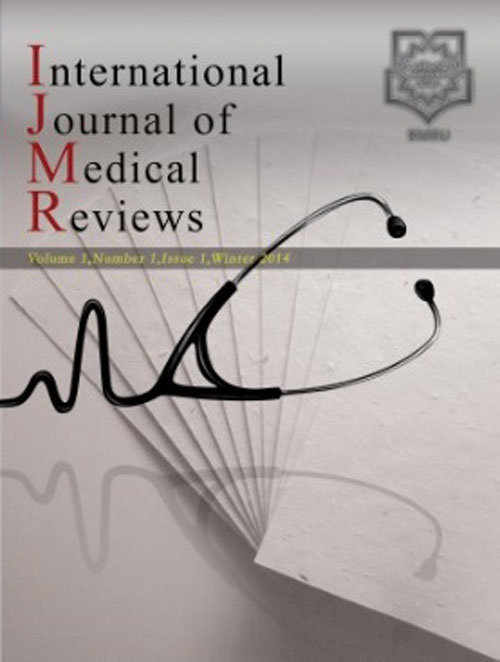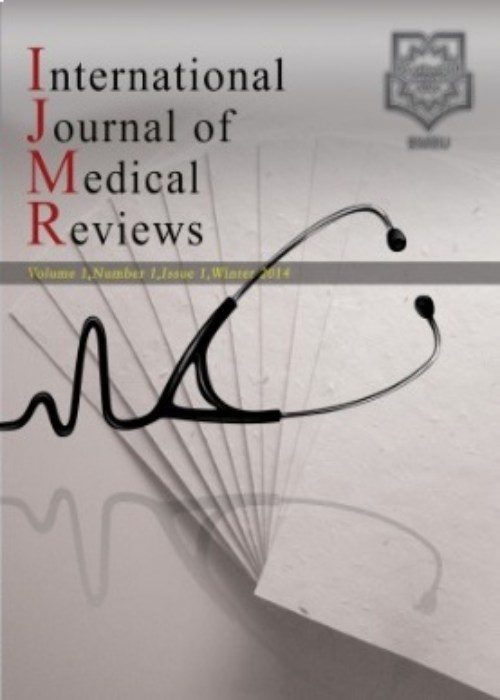فهرست مطالب

International Journal of Medical Reviews
Volume:3 Issue: 4, Autumn 2016
- تاریخ انتشار: 1395/09/30
- تعداد عناوین: 7
-
Pages 495-496Systematic reviews as secondary research studies are used as the gold standard to help healthcare professionals and healthcare policy makers in decision making. Clinical decisions need to be based on high quality, up-to-date research evidence. Systematic reviews start with well-defined research questions and explicit and reproducible search strategies in order to critically appraise and integrate results of primary research studies.Keywords: Systematic Review, Decision Making, Healthcare
-
Pages 497-500A chronic subdural hematoma (CSDH) is an encapsulated collection of blood and fluid on the surface of the brain. It is a common condition, especially in elderly patients, with an incidence of 58 cases per 100,000 people per year in patients over 65 years of age, a mortality rate of about 2%, and a recurrence rate ranging from 11.7% to 28% despite surgical and medical treatments. Due to the high incidence of CSDH, a vast amount of literature exists on the various medical and surgical aspects. Moreover, the literature contained meta-analyses analyzing different techniques, medical therapies, and factors associated with prognoses. Herein, the available literature and meta-analyses on different aspects of CSDH are reviewed in order to provide a rapid review of the best evidence regarding this condition. Twelve meta-analyses comparing the effects of different surgical and/or medical treatments on various different clinical outcomes were analyzed. Strong evidence was found that: 1) burr-hole craniostomy and twist-drill craniostomy are both efficacious in treating CSDH; 2) drainage placement is associated with better clinical outcomes and significantly lower recurrence rates; 3) antithrombotic drugs are significantly associated with a higher recurrence rate; and 4) in case of need of reoperation, open craniotomy is associated with better outcomes compared with minimally invasive procedures. Further studies are needed to clarify the role of corticosteroids and the best timing of the resumption of antithrombotic drugs after CSDH evacuation.Keywords: Chronic Subdural Hematoma, Surgery, Drug Therapy, Meta, Analysis, Review
-
Pages 501-503Liquid biopsy as a new rising non-invasive testing method plays an important role in assist of the diagnosis, evaluation of the efficacy and prognosis, monitoring of early recurrence and drug resistance. It has been widely applied in some type of solid tumors. Lymphoma is a group of heterogeneous hematological malignancies which most subtypes without specific tumor markers and evaluation of the efficacy and prognostic is mainly depends on and limited to biopsy and imaging. Compared to other solid tumors, lymphoma tumor cells were characterized with access to peripheral easier and immunoglobulin molecules diversity can be monitored as marker, which is more applicable to liquid biopsy. With advances in the detection technology, research and application of liquid biopsy in lymphoma has attracted more attentions.Keywords: Liquid Biopsy, Circulating Tumor DNA, Lymphoma
-
Pages 504-507Around 800 000 to 1 million people die by suicide annually, making suicide the 10th leading cause of death worldwide. Suicide rates are higher among men than women, and the probability of suicide is 3 to 4 times higher for men than for women. Non-lethal suicide is more common in young people and women. The type of suicide seen in different countries depends on the culture, economic, and social conditions in the respective country. Also, differences in types of suicide are partly due to the availability of various methods. In recent years, the percentage of suicides has risen in all countries. Surveys show that the most prominent methods of suicide in most countries in the world are hanging and poisoning. The most deadly type of suicide is by gun. The most unsuccessful suicide attempts are overdoses of medication. Knowing about the available suicide methods is important.Keywords: Suicide, Type of Suicide, Countries
-
Pages 508-514Low back pain (LBP), a common disorder involving the muscles, nerves, and bones of the back, is associated with lumbar disc degeneration. It is a complex phenomenon, likely the result of a combination of biochemical and biomechanical factors that are known to occur in discs. However, the findings of previous studies have suggested that disc degeneration may be explained primarily by genetic influences. For this reason, scientists are interested in the use of genes/proteins for the treatment of disc degeneration. Protein-based therapies involve the administration of biologic factors into the intervertebral disc to enhance matrix synthesis, postpone degeneration, and prevent inflammation. These factors can be delivered by an intradiscal injection, alone or in combination with cells or tissue scaffolds, and by gene therapy. A systematic search for articles dated from 1990 to the present was performed to identify pertinent articles related to the topic of the role of gene therapy in treating intervertebral disc degeneration. Twenty-seven studies reported the use of at least one gene in treating this disease through gene therapy. Researchers have been performing phases I/II of a clinical trial on the treatment of disc degeneration with gene therapy since 2008. Recent studies have shown that gene therapy may have promise as a method of slowing down or preventing some of the changes seen in intervertebral discs. However, because the clinical trial is not complete and therefore the results are indeterminate, this method cannot be proffered as a replacement for surgery. It is hoped that definitive results of the possible effects of gene therapy on the human body will be acquired soon.Keywords: Gene Therapy, Lumbar Disc Disease
-
Pages 515-522IntroductionThe celiac artery is nestled deep within the abdomen and provides blood flow to the foregut. Injuries to the celiac artery are rare and carry a high mortality rate.MethodsA systematic MEDLINE Complete literature search was performed following the Preferred Reporting Items for Systematic Reviews and Meta-Analyses (PRISMA) guidelines. Relevant studies, specifically those focusing on diagnosis and management of traumatic celiac arterial injuries were selected, excluding pediatric and iatrogenic cases. Studies from all years were considered, given the paucity of literature on this topic. Studies included in the review were categorized according to level of evidence.ResultsThe initial search yielded 5295 results. Specifiers and removing duplicates reduced this number to a final result of 226 studies. After applying exclusion criteria, there were 33 remaining studies containing a total of 175 patients. Of these, only 5 had greater than ten patients in the study, and the majority of the remaining studies were level IV and V evidence. Of the studies reporting deaths, the overall mortality was 34%.ConclusionInjuries to the celiac artery are very rare and occur as a result of penetrating or blunt trauma. These injuries carry a high mortality rate and early recognition requires a high index of suspicion. Diagnosis is based on CT imaging or direct visualization during an exploratory laparotomy. Treatment modalities include open repair, endovascular repair, ligation and medical management. Currently, given the lack of available studies, there is no uniform or agreed-upon treatment approach.Keywords: Celiac Trunk, Trauma, Haller's Tripod
-
Pages 523-524We have read a recent article about intravitreal pharmacotherapy for the treatment of macular edema secondary to branch retinal vein occlusion (BRVO) with great interest. You have mentioned that few studies have evaluated the efficacy of pegaptanib in ocular diseases; thus, discussing this the Food and Drug Administration (FDA)-approved drug is necessary.
Anti-VEGF therapy is a critical and potent approach for the management of macular edema. Anti-VEGF agents neither cause ruined alterations as lasers do, nor induce cataract formation as steroids do.


